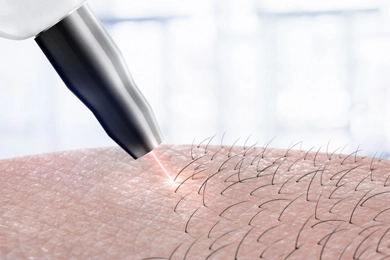
When considering permanent hair removal solutions, two methods dominate the industry: electrolysis and laser hair removal. Both offer long-term solutions to unwanted hair, but the processes, technologies, and results can vary. Let's delve deep into understanding these differences to guide your decision and clarify what each method entails.
Electrolysis: This method uses an electric current to destroy the hair follicle. A fine probe is inserted into each hair follicle, after which an electric current is applied, leading to the destruction of the follicle.
Laser Hair Removal: It employs concentrated light energy. The melanin (pigment) in the hair absorbs this light, converting it into heat that damages the follicle, slowing or inhibiting future growth.
Electrolysis: Given its one-by-one approach to targeting hair follicles, electrolysis sessions can be lengthier. For extensive areas, multiple sessions spaced weeks apart are necessary. It's worth noting that smaller areas, like the eyebrows, might be quicker to treat.
Laser Hair Removal: These treatments can target multiple follicles simultaneously, making them more suitable for larger areas like the legs or back. However, multiple sessions are still required (typically 4-8) spaced a month or more apart to achieve desired results.
Electrolysis: It's versatile and suitable for all skin tones and hair types, including gray, blonde, or fine hairs which lasers might miss.
Laser Hair Removal: Historically, it was most effective on individuals with light skin and dark hair. However, advancements have led to the development of lasers suitable for darker skin tones. Yet, it's less effective on light-colored hair.
Electrolysis: Patients often describe a stinging or pricking sensation. Topical anesthetics can be applied to reduce discomfort.
Laser Hair Removal: The sensation is frequently compared to the snap of a rubber band against the skin. Cooling mechanisms or gels are often used to mitigate pain.
Electrolysis: Potential side effects include redness, swelling, and minor pain post-treatment. There's a minor risk of scarring or skin discoloration if not performed correctly.
Laser Hair Removal: Temporary redness, discomfort, and swelling are common post-treatment. There's a risk of burns, blisters, or skin discoloration, especially if the procedure isn't done by experienced hands or if post-treatment care instructions aren't followed.
Electrolysis: Given the extended number of sessions required and the time-consuming nature of the treatment, electrolysis can be costlier over time.
Laser Hair Removal: The initial cost is higher than other hair removal methods. However, due to fewer sessions required for larger areas, it might be more cost-effective in the long run.
Electrolysis: It's approved by the FDA for permanent hair removal. However, some patients might require touch-up sessions over the years.
Laser Hair Removal: The FDA approves it for "permanent hair reduction." It doesn't guarantee the permanent removal of all hair, but a significant reduction is expected. Touch-up sessions might be needed annually.
Electrolysis: Patients should avoid sun exposure and refrain from using skincare products that can irritate the treated area for a couple of days.
Laser Hair Removal: Avoiding sun exposure and using sunscreen is crucial. It's also advised to skip other hair removal methods like waxing or plucking between sessions.
Both electrolysis and laser hair removal have their advantages, and the best method depends on individual needs, hair type, and budget. It's essential to consult with a trained professional who can provide insights tailored to your specific requirements. By making an informed choice, you can enjoy smoother, hair-free skin with results that last.
Electrolysis uses electric currents to damage hair follicles permanently, whereas laser hair removal targets hair pigments with light beams to inhibit growth.
Electrolysis is FDA-approved as a permanent hair removal method, while laser hair removal can significantly reduce hair growth but may require maintenance treatments.
Pain is subjective, but many find laser hair removal quicker and less painful, whereas others might feel slight discomfort with electrolysis.
Electrolysis usually requires more frequent sessions than laser hair removal, which offers quicker coverage.
Electrolysis can treat all skin types, whereas laser hair removal traditionally works best on light skin with dark hair. However, newer lasers cater to darker skin tones.
Electrolysis is effective on all hair colors, including blonde, gray, and red, while laser hair removal is most effective on darker hair.
Electrolysis sessions can vary from 15 minutes to an hour, while laser hair removal might range from minutes for smaller areas to an hour for larger regions.
Initial sessions of electrolysis may cost less, but the need for more frequent treatments might make it pricier in the long run. Laser hair removal, though costlier per session, typically requires fewer visits.
Both have minimal recovery, but laser hair removal might show more immediate redness and swelling.
Both electrolysis and laser hair removal are safe for facial hair when done by professionals. However, the individual's skin type, hair color, and sensitivity should dictate the best method.
Electrolysis can cause temporary redness, minor swelling, and small scabs. Laser hair removal might result in temporary redness, swelling, and potential pigmentation changes.
Laser hair removal often shows quicker results, with hair thinning after the initial sessions. Electrolysis requires a more consistent and extended treatment plan.
When conducted by trained professionals, risks are minimal for both. However, poor execution can result in scarring or skin discoloration.
Laser hair removal is generally preferred for larger areas due to its quicker treatment time.
For laser treatments, patients are advised to avoid sun exposure and not to wax or pluck hairs beforehand. Electrolysis doesn't have as many pre-treatment restrictions but might require hair to be at a certain length.
Both methods advise avoiding sun exposure post-treatment. However, after laser hair removal, patients might be instructed to avoid specific activities that cause sweating or heat in the treated area.
Both treatments are generally safe for the skin when done correctly. However, improper technique or settings can cause burns or pigmentation changes.
Electrolysis has been around for over a century and has more historical data. Laser hair removal, while newer, has been extensively studied in recent decades.
Electrolysis might be preferred for highly sensitive skin. Still, modern lasers with cooling mechanisms can make laser hair removal comfortable for sensitive skin types.
Yes, both electrolysis and laser hair removal can be effective in treating and preventing ingrown hairs.
 Everything About Male Laser Hair Removal
Everything About Male Laser Hair RemovalIn recent times, men who are looking for a long-term solution to undesirable body hair have grown more and more interested in laser hair removal. ...
 Laser Hair Removal vs. Electrolysis: Which is Right for You?
Laser Hair Removal vs. Electrolysis: Which is Right for You?Two popular techniques—Laser Hair Removal and Electrolysis—have emerged as front-runners in the race for smooth, hair-free skin. ...
 What Factors Affect Laser Hair Removal Prices?
What Factors Affect Laser Hair Removal Prices?The cost of treatment of laser hair removal may increase for clinics located in affluent or cosmopolitan areas due to higher operational expenses such as rent, utilities, and salaries. ...
 Acne After Laser Hair Removal And Its Treatment
Acne After Laser Hair Removal And Its TreatmentUnwanted hair can be removed from various parts of the body using the popular and efficient laser hair removal procedure. It provides a long-lasting method to stop hair growth, leaving skin that is smooth an ...
 Medications You Should Avoid While Receiving Laser Hair Removal
Medications You Should Avoid While Receiving Laser Hair RemovalUsing a laser to eliminate unwanted body hair is a common cosmetic technique known as laser hair removal. Many people elect to undergo laser hair removal in order to obtain a smoother, hair-free appearance b ...